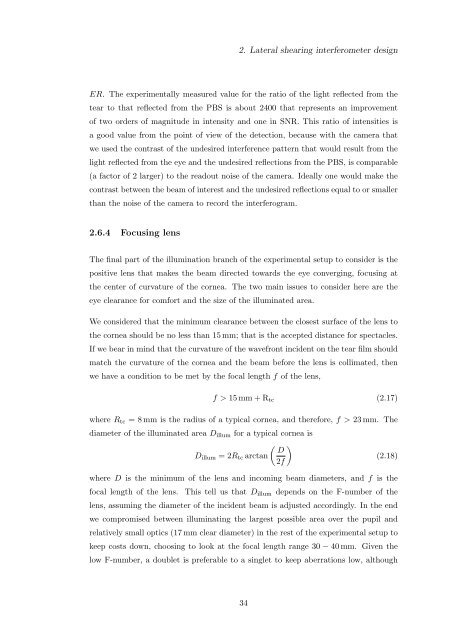Alfredo Dubra's PhD thesis - Imperial College London
Alfredo Dubra's PhD thesis - Imperial College London
Alfredo Dubra's PhD thesis - Imperial College London
Create successful ePaper yourself
Turn your PDF publications into a flip-book with our unique Google optimized e-Paper software.
2. Lateral shearing interferometer design<br />
ER. The experimentally measured value for the ratio of the light reflected from the<br />
tear to that reflected from the PBS is about 2400 that represents an improvement<br />
of two orders of magnitude in intensity and one in SNR. This ratio of intensities is<br />
a good value from the point of view of the detection, because with the camera that<br />
we used the contrast of the undesired interference pattern that would result from the<br />
light reflected from the eye and the undesired reflections from the PBS, is comparable<br />
(a factor of 2 larger) to the readout noise of the camera. Ideally one would make the<br />
contrast between the beam of interest and the undesired reflections equal to or smaller<br />
than the noise of the camera to record the interferogram.<br />
2.6.4 Focusing lens<br />
The final part of the illumination branch of the experimental setup to consider is the<br />
positive lens that makes the beam directed towards the eye converging, focusing at<br />
the center of curvature of the cornea. The two main issues to consider here are the<br />
eye clearance for comfort and the size of the illuminated area.<br />
We considered that the minimum clearance between the closest surface of the lens to<br />
the cornea should be no less than 15 mm; that is the accepted distance for spectacles.<br />
If we bear in mind that the curvature of the wavefront incident on the tear film should<br />
match the curvature of the cornea and the beam before the lens is collimated, then<br />
we have a condition to be met by the focal length f of the lens,<br />
f > 15 mm + R tc (2.17)<br />
where R tc = 8 mm is the radius of a typical cornea, and therefore, f > 23 mm. The<br />
diameter of the illuminated area D illum for a typical cornea is<br />
( ) D<br />
D illum = 2R tc arctan<br />
(2.18)<br />
2f<br />
where D is the minimum of the lens and incoming beam diameters, and f is the<br />
focal length of the lens. This tell us that D illum depends on the F-number of the<br />
lens, assuming the diameter of the incident beam is adjusted accordingly. In the end<br />
we compromised between illuminating the largest possible area over the pupil and<br />
relatively small optics (17 mm clear diameter) in the rest of the experimental setup to<br />
keep costs down, choosing to look at the focal length range 30 − 40 mm. Given the<br />
low F-number, a doublet is preferable to a singlet to keep aberrations low, although<br />
34

















